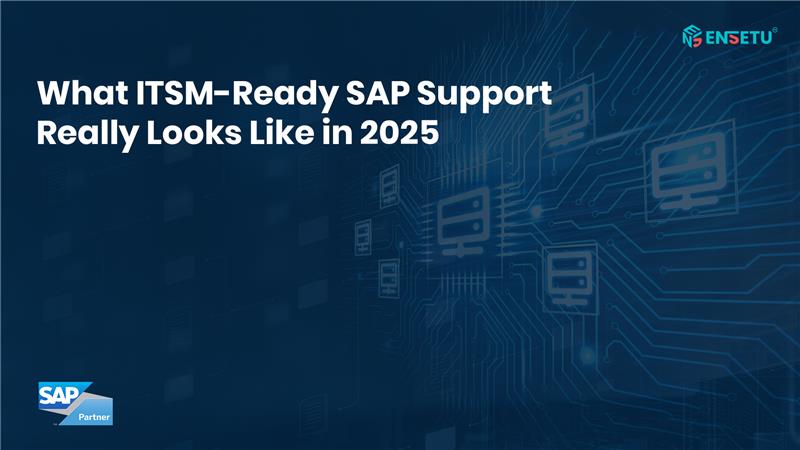
Behind every successful transaction in your global business, there is an SAP system invisibly underpinning the entire operation. But come 2025, keeping that system up and running will require more than just traditional support. Whether finance, supply chain, or customer engagement, organizations are reliant on SAP systems to run smoothly. However, the complexity of hybrid landscapes, regulatory compliance, and the demand for continuous uptime require more than traditional support models from stakeholders. ITSM ready SAP support will not just be fixing incidents.
By 2025, we’ll have to build transparency, governance, and automation into the support processes themselves. Builders of the ITSM-ready SAP support ecosystem will focus on establishing change logs, audit trails, and SLA dashboards, all powered by AI, integrations, and compliance-ready workflows.
1. Change Logs: The Initial Layer of Transparency
To manage SAP safely, you need accountability first. It can be as simple as a minor change in a configuration or transport and it will significantly affect the downstream if there is no trace of the change. This is the real reason why detailed change logs are the first layer of ITSM ready support.
Change logs essentially give you answers to the following questions: Who implemented or approved the change? What object or configuration was changed? When was the original change made? Why was the change made, and what ITSM ticket was it associated with?
By 2025 with tools like ServiceNow’s ITSM Connector for SAP the process had become easy. A change made in SAP GUI was entered as a ticket which automatically included error dumps, Fiori app details and relevant SAP notes. This created links establishing a transparent chain of technical changes related to business requests.
Suppliers’ customers have realized real value. An example is a European retail group which used integrated change logging and reduced root cause analysis time by around 30 percent. Their IT teams were no longer required to follow up on emails and spreadsheets to know what had changed, because all changes were connected back to an exact ticket history.
The benefits in 2025 included:
-
Clear accountability across the entire support lifecycle
-
Faster troubleshooting through well-documented histories
-
Audit readiness with change logs tied directly to business cases
2. Audit Trails: Strengthening Trust and Compliance
While transparency through change logs is essential, it is audit trails that close the loop by embedding governance and policy checks. A strong audit trail captures the full flow from the person who made a change, to the manager who approved it, to the ITSM ticket that justified it.
Tools such as SAP Solution Manager and third-party integrations such as REALTECH SAP ITSM Integration are setting new standards in 2025. These tools make it easy for users to ensure that all incidents, transports, and approvals were recorded consistently without duplication or manual effort. AI-enabled anomaly detection provides another level of tracking although deviance is flagged in near real time, making it much more apparent.
An example from a global manufacturer which is a current SAP S/4HANA user demonstrates this value well. Prior to their integration with ServiceNow, the approval workflows for audit purposes consisted of spreadsheets and emails. With ServiceNow and oversight automated, every transaction and transport were now automatically traceable and preparation time for audits was reduced by 40 percent. Also, executives were now confident that segregation of duties policies were being enforced.
The benefits in 2025 include:
-
Audit-ready documentation aligned to SOX, GDPR, HIPAA, or ISO standards
-
Strong forensic capabilities for investigating incidents quickly
-
Consistent enforcement of governance and compliance rules
3. SLA Dashboards: Turning Agreements into Action
Service Level Agreements (SLAs) were once static metrics noted in contracts. In 2025, they are living systems embedded into dashboards that drive real-time decision making.
Modern SLA dashboards track response times, resolution times, distribution of tickets by SAP module, and recurring issues such as job failures or Fiori app errors. Advanced dashboards even trigger pre-breach alerts so that teams can resolve potential violations before they occur.
For instance, ServiceNow’s ITSM Connector for SAP provides interactive dashboards that display incident trends, ticket volumes, and priority breakdowns across different SAP systems. Platforms such as Siit, take it one step further by establishing escalation triggers when SLA compliance dips to 80 percent of a threshold.
An Asian manufacturing company implemented these SLA dashboards on their supply chain modules. Executives were able to leverage predictive alerts to detect trends in repeated performance declines, resulting in 15 percent more uptime. This company changed its operations mode to a preventive model of support preventing delays from impacting operational loading.
The benefits in 2025 were:
-
Proactive prevention of SLA breaches
-
Real-time visibility of IT performance
-
Stronger alignment of IT delivery to direct business objectives
Beyond the Essentials: Larger value drivers
Change logs, audit trails, and SLA dashboards are the three most critical areas of ITSM-ready SAP support; however, the broader umbrella of value in 2025 extends well past these three capabilities:
-
AI and Automation: Artificial intelligence powered routing and auto-remediation of incident resolutions will significantly reduce human effort and timeline.
-
DevOps-aligned change pipelines: With tools such as Rev-Trac Integration for ServiceNow it is possible to automate triggering SAP transports to ServiceNow Change requests creating CI/CD-like workflows, while also retaining full traceability throughout the process.
Final Thoughts
ITSM-ready SAP support will not be a “nice to have” by 2025, it will be a pillar of operational resilience, compliance, and efficiency. Change logs provide transparency. Audit trails provide oversight. SLA dashboards bring accountability and proactive service. The combination of automation, AI, identity governance, and modern integration practices will create support that is a competitive advantage for organizations and not merely a cost center. Organizations adopting this model will mitigate risk, expedite resolution times, manage audit requests, and continually deliver business-critical uptime. In a world where digital trust and uptime are always top of mind, ITSM-ready SAP support is the new benchmark for performance.